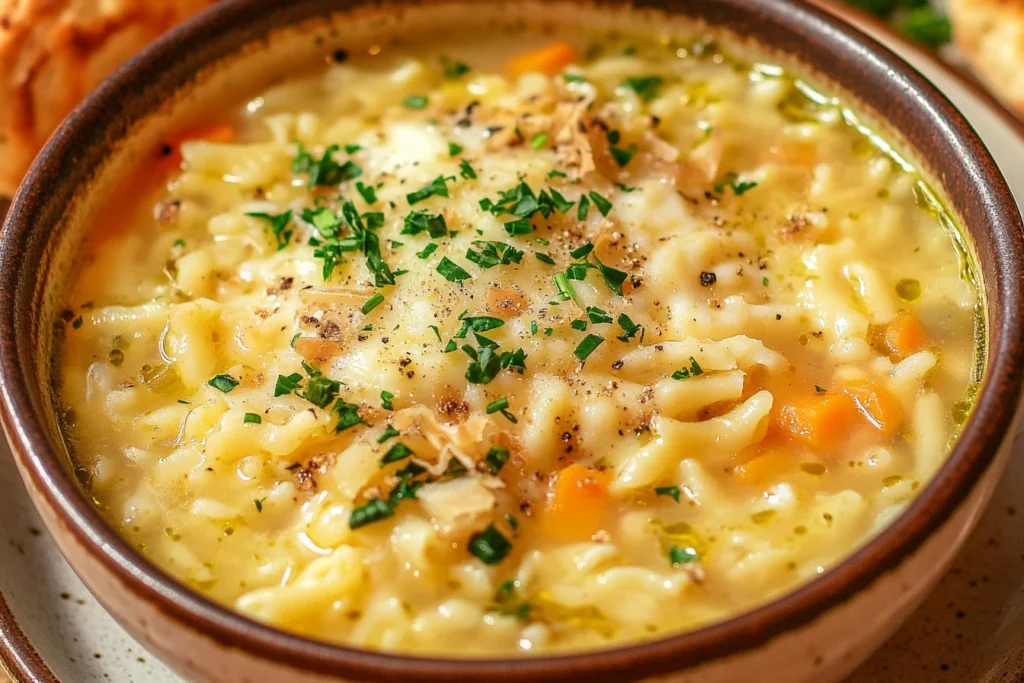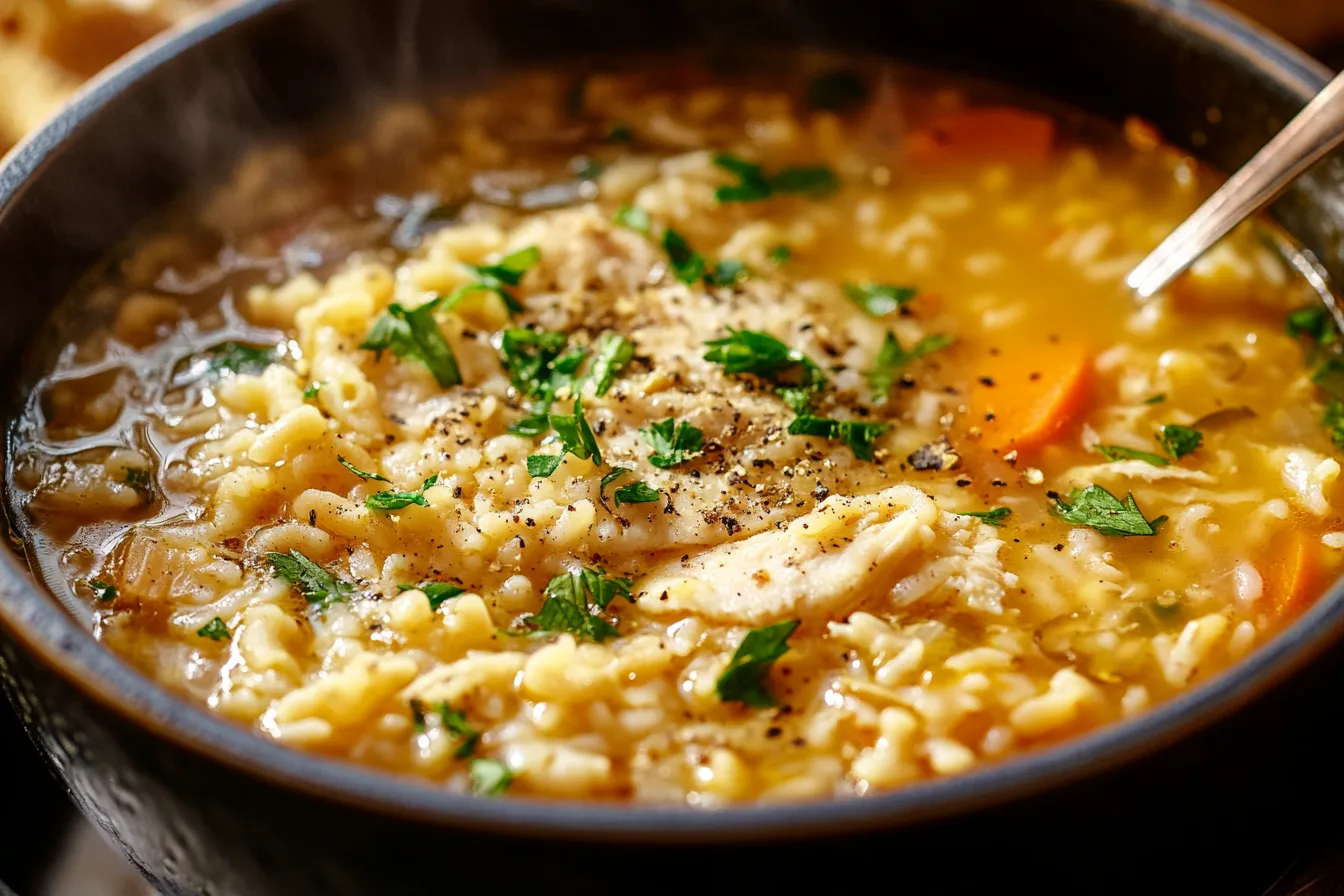Chicken Pastina Soup is a comforting, hearty dish made with tiny pasta pieces called pastina, tender chicken, fresh vegetables, and a flavorful broth. Known as a staple in Italian households, this soup is often served as a remedy for colds or as a warm, nourishing meal on chilly days.

The star ingredient, pastina (Italian for “little pasta”), adds a unique texture to the soup, making it a favorite for children and adults alike.
The History and Cultural Significance of Chicken Pastina Soup
Chicken Pastina Soup has deep roots in Italian cuisine, often associated with nonna’s kitchen (grandmother’s cooking). Its simplicity and nutritional value made it a popular dish during times of economic hardship, as it could stretch limited ingredients into a satisfying meal.
How Pastina Became a Comfort Food Classic
Pastina holds a special place in Italian culture as a symbol of comfort and care. Often referred to as Italian penicillin, it’s a go-to meal for soothing colds, calming upset stomachs, or simply warming the soul. Its small, soft pasta pieces make it easy to eat, even for young children or those feeling under the weather.
The Role of Chicken Soup in Italian and Global Cuisine
While chicken soup is a global comfort food, its Italian version stands out for incorporating pastina, fresh herbs, and a focus on high-quality, simple ingredients. Variations of chicken soup appear in cuisines worldwide, from American-style chicken noodle soup to Southeast Asian chicken and rice soups.
Key Ingredients for Chicken Pastina Soup
Understanding Pastina: Varieties and Types
Pastina comes in various shapes, including:
- Stelline: Star-shaped pasta, a favorite for kids.
- Acini di Pepe: Tiny, round pasta that resembles pearls.
- Orzo: Rice-shaped pasta, often used as a substitute.
Each type contributes a slightly different texture, so choose based on preference or availability.
The Importance of Fresh Chicken in the Recipe
Using fresh chicken, especially bone-in pieces like thighs or a whole chicken, creates a rich, flavorful broth. Opt for:
- Organic or Free-Range Chicken: For the best flavor and nutritional value.
- Rotisserie Chicken: A quick alternative for shredding into the soup.
Vegetables and Herbs That Enhance Flavor
Essential vegetables include:
- Carrots, Celery, and Onion: The classic mirepoix for a deep, savory base.
- Fresh Herbs: Parsley, thyme, or bay leaves add aromatic depth.
Nutritional Benefits of Chicken Pastina Soup
Why Chicken Soup Is Known as a Healing Food
Chicken soup is often touted for its medicinal qualities:
- Hydration: Replenishes fluids when you’re feeling sick.
- Protein: From chicken, aids in tissue repair and immunity.
- Anti-Inflammatory Properties: Warm broth can help ease cold symptoms.
Balancing Carbs, Protein, and Vitamins in One Bowl
Chicken Pastina Soup provides a balanced meal:
- Carbs: From pastina, offering energy.
- Protein: From chicken, supporting muscle health.
- Vitamins and Fiber: From fresh vegetables, promoting overall well-being.
Tools and Equipment Needed
The Best Pots for Making Soup
- Large Stockpot: Ideal for cooking broth and soup in one pot.
- Dutch Oven: Retains heat well for slow cooking.
Knives, Cutting Boards, and Ladles
- Sharp Knife: For precision in chopping vegetables and chicken.
- Wooden Cutting Board: Durable and easy to clean.
- Ladle: For serving soup without mess.
Step-by-Step Guide to Making Chicken Pastina Soup
How to Make the Perfect Chicken Pastina Soup
Crafting the perfect Chicken Pastina Soup requires attention to detail, from preparing the ingredients to achieving the right balance of flavors. This step-by-step guide will help you create a comforting bowl of soup that’s rich in taste and nutrition.
Preparation Steps
Selecting and Preparing the Chicken
- Choosing the Right Chicken:
- Use bone-in chicken thighs, drumsticks, or a whole chicken for a more flavorful broth.
- For convenience, shredded rotisserie chicken works well.
- Preparing the Chicken:
- Rinse the chicken under cold water and pat dry.
- Trim excess fat, but leave some skin for added flavor.
Prepping Vegetables: Onion, Carrots, Celery, and More
- Chop the Mirepoix:
- Dice 1 onion, 2–3 carrots, and 2–3 celery stalks into small, uniform pieces.
- Optional Additions:
- Mince 2–3 garlic cloves for extra depth.
- Dice zucchini or add a handful of spinach for added nutrients.
Pro Tip: Keep the vegetable pieces small so they cook evenly and blend harmoniously with the pastina.
Washing and Measuring Pastina
- Measure about 1 cup of pastina for a pot of soup serving 4–6 people.
- Rinse the pastina in cold water to remove excess starch if desired.
Cooking the Chicken Broth
How to Make Homemade Chicken Broth
Homemade broth is the foundation of Chicken Pastina Soup:
- Combine Ingredients:
- Place chicken, 8 cups of water, and the mirepoix in a large stockpot.
- Add 2–3 sprigs of parsley, thyme, and 1 bay leaf for aromatics.
- Simmer:
- Bring to a boil, then reduce heat to low and simmer for 45–60 minutes.
- Skim any foam or impurities that rise to the surface.
- Strain and Shred:
- Remove the chicken and strain the broth through a fine sieve.
- Shred the chicken into bite-sized pieces, discarding bones and skin.
Using Store-Bought Broth as a Time-Saver
- If short on time, use high-quality store-bought chicken broth.
- Enhance its flavor by simmering it with a few fresh herbs and garlic for 10–15 minutes before adding other ingredients.
Enhancing Broth Flavor with Herbs and Spices
- Add a teaspoon of dried thyme or oregano for herbal notes.
- Season with salt and freshly ground pepper to taste.
- Optional: A squeeze of lemon juice brightens the flavor and balances richness.
Adding Pastina to the Soup
Cooking Pastina Without Overcooking
- Add Pastina to Simmering Broth:
- Stir in pastina and cook for 5–7 minutes, or until tender.
- Monitor Closely:
- Avoid overcooking, as pastina can become mushy and absorb too much liquid.
Pro Tip: Cook pastina separately and add it to each bowl before serving if you plan to store leftovers.
Timing for Adding Vegetables and Other Ingredients
- Vegetables:
- Add hard vegetables (carrots, celery) at the start for a softer texture.
- Add delicate greens (spinach, kale) in the last 2–3 minutes of cooking.
- Chicken:
- Stir in shredded chicken during the final 5 minutes to warm it through.
Adjusting the Consistency of the Soup
- Thicker Soup:
- Reduce the broth slightly or add a slurry of cornstarch and water.
- Thinner Soup:
- Add more broth or water and adjust seasoning accordingly.
Final Touches and Serving
Garnishing with Fresh Herbs and Parmesan Cheese
- Herbs: Top with chopped parsley, dill, or basil for freshness.
- Cheese: Sprinkle grated Parmesan or Pecorino Romano for a savory finish.
Adjusting Seasoning: Salt, Pepper, and Lemon
Taste and tweak the seasoning before serving:
- Add a pinch of salt or pepper to enhance the flavors.
- A squeeze of lemon juice balances the richness and adds brightness.
Part 3: Variations, Serving, and Storage of Chicken Pastina Soup
Creative Variations of Chicken Pastina Soup
Chicken Pastina Soup is a versatile dish that can be adapted to suit various dietary preferences, flavor profiles, and nutritional needs. Here are some popular variations to inspire your next bowl:
Healthier Options: Low-Sodium, Gluten-Free, and Dairy-Free
- Low-Sodium Version:
- Use homemade chicken broth with minimal salt.
- Season with herbs like thyme, parsley, and oregano to compensate for reduced saltiness.
- Gluten-Free Pastina Soup:
- Substitute pastina with gluten-free alternatives like rice, quinoa, or gluten-free pasta.
- Ensure all other ingredients, such as broth, are certified gluten-free.
- Dairy-Free Adaptation:
- Skip the Parmesan cheese garnish.
- Enhance flavor with a splash of olive oil or nutritional yeast for a cheesy taste without dairy.
Adding Greens: Spinach or Kale for Extra Nutrition
- Spinach:
- Stir in a handful of baby spinach during the last 2–3 minutes of cooking.
- It wilts quickly, adding nutrients without altering the flavor.
- Kale:
- Add chopped kale 5–7 minutes before serving for a heartier texture.
- Remove thick stems for a smoother eating experience.
Incorporating Other Proteins: Turkey or Tofu
- Turkey:
- Use shredded turkey leftovers from a holiday meal.
- Simmer in the broth for a similar richness to chicken.
- Tofu:
- Add cubed, firm tofu for a vegetarian-friendly protein source.
- Marinate the tofu in a mix of olive oil, garlic, and soy sauce before adding it to the soup for enhanced flavor.
Creamy Chicken Pastina Soup: A Twist with Cream or Milk
Transform the traditional recipe into a creamy delight:
- Ingredients:
- Add ½–1 cup of heavy cream or whole milk.
- For a lighter option, use unsweetened almond milk or coconut milk.
- Preparation:
- Stir in the cream during the last few minutes of cooking, ensuring it doesn’t boil to prevent curdling.
Serving Suggestions
Pairing Chicken Pastina Soup with Bread or Crackers
- Bread:
- Serve with crusty sourdough, baguette slices, or garlic bread to soak up the flavorful broth.
- Crackers:
- Use saltine crackers, whole-grain options, or cheesy crackers for added crunch.
Making It a Meal: Side Dishes That Complement the Soup
- Salads:
- A simple mixed greens salad with a light vinaigrette balances the richness of the soup.
- Roasted Vegetables:
- Serve roasted carrots, asparagus, or Brussels sprouts as a hearty side dish.
- Cheese Plate:
- A small selection of mild cheeses like mozzarella or provolone complements the Italian-inspired flavors.
How to Store and Reheat Chicken Pastina Soup
Proper storage and reheating techniques help preserve the soup’s flavor and texture, making it a great option for meal prep.
Refrigeration Tips for Maximum Freshness
- Storage:
- Allow the soup to cool completely before transferring it to an airtight container.
- Store in the refrigerator for up to 3–4 days.
- Separate Components:
- If storing leftovers, keep the cooked pastina separate from the broth to prevent it from becoming overly soft.
Freezing Chicken Pastina Soup for Long-Term Storage
- Preparation for Freezing:
- Cool the soup completely.
- Store in freezer-safe containers, leaving 1–2 inches of space for expansion.
- Freezing Duration:
- Soup can be frozen for up to 3 months.
- Thawing and Reheating:
- Thaw in the refrigerator overnight.
- Reheat on the stovetop over low heat, adding a splash of water or broth if the soup has thickened.
Best Practices for Reheating Without Altering Texture
- Stovetop:
- Heat gently over medium-low heat, stirring occasionally to ensure even warming.
- Microwave:
- Heat individual portions in a microwave-safe bowl, covering with a damp paper towel to retain moisture.
- Prevent Overcooking:
- Reheat only until warmed through to avoid mushy pastina or overcooked vegetables.
Fun Facts and Trivia About Chicken Pastina Soup
The Role of Pastina in Italian Home Cooking
- Pastina as Baby Food:
- In Italy, pastina is often the first solid food given to children due to its small size and soft texture.
- A Symbol of Care:
- Chicken Pastina Soup is a traditional dish served to comfort loved ones, whether they’re sick or simply in need of a warm hug in a bowl.
Why Chicken Soup Is Universally Loved
- Cultural Variations:
- From matzo ball soup in Jewish cuisine to pho in Vietnam, chicken-based soups are a global symbol of comfort.
- Scientific Support:
- Studies suggest chicken soup may help alleviate cold symptoms by reducing inflammation and providing hydration.
More FAQs
- What type of pastina is best for soup?
Stelline (stars) and acini di pepe (tiny pearls) are popular choices due to their size and texture. - Can I make this soup vegetarian?
Yes, substitute the chicken with tofu or chickpeas and use vegetable broth. - How do I prevent pastina from getting mushy?
Cook it separately and add it to the soup just before serving. - Can I add more vegetables?
Absolutely! Diced zucchini, green beans, or peas work well. - What can I use instead of pastina?
Orzo, couscous, or rice are great substitutes. - How long does the soup last in the fridge?
Properly stored, it will last for 3–4 days. - Can I make the soup creamy?
Yes, stir in heavy cream or milk during the last few minutes of cooking. - Is homemade broth necessary?
While homemade broth adds depth, high-quality store-bought broth works too. - How do I reheat frozen soup?
Thaw overnight in the fridge and reheat gently on the stovetop. - What makes this soup so comforting?
Its balance of warm broth, tender chicken, and soft pastina creates a soothing, nourishing experience.

Chicken Pastina Soup
Equipment
- Large pot
- Ladle
- Knife
- Cutting Board
- Mixing spoon
Ingredients
Main Ingredients
- 1 pound chicken breast boneless and skinless
- 6 cups chicken broth
- 1 cup pastina pasta
- 2 tablespoons olive oil
- 1 medium onion diced
- 2 medium carrots diced
- 2 stalks celery diced
- 2 cloves garlic minced
- 1/4 teaspoon dried thyme
- 1/4 teaspoon dried parsley
- to taste salt and black pepper
- 1/4 cup grated Parmesan cheese optional, for serving
Instructions
- Heat olive oil in a large pot over medium heat. Add diced onion, carrots, and celery. Sauté for 5-7 minutes until softened.
- Add minced garlic, dried thyme, and dried parsley. Cook for 1-2 minutes until fragrant.
- Pour in the chicken broth and add the chicken breast. Bring to a boil, then reduce the heat to low. Simmer for 15 minutes, or until the chicken is cooked through.
- Remove the chicken breast from the pot and shred it using two forks. Return the shredded chicken to the pot.
- Add the pastina pasta to the pot and cook for 5-7 minutes, or until the pasta is tender. Season the soup with salt and black pepper to taste.
- Ladle the soup into bowls and garnish with grated Parmesan cheese if desired. Serve warm and enjoy!
